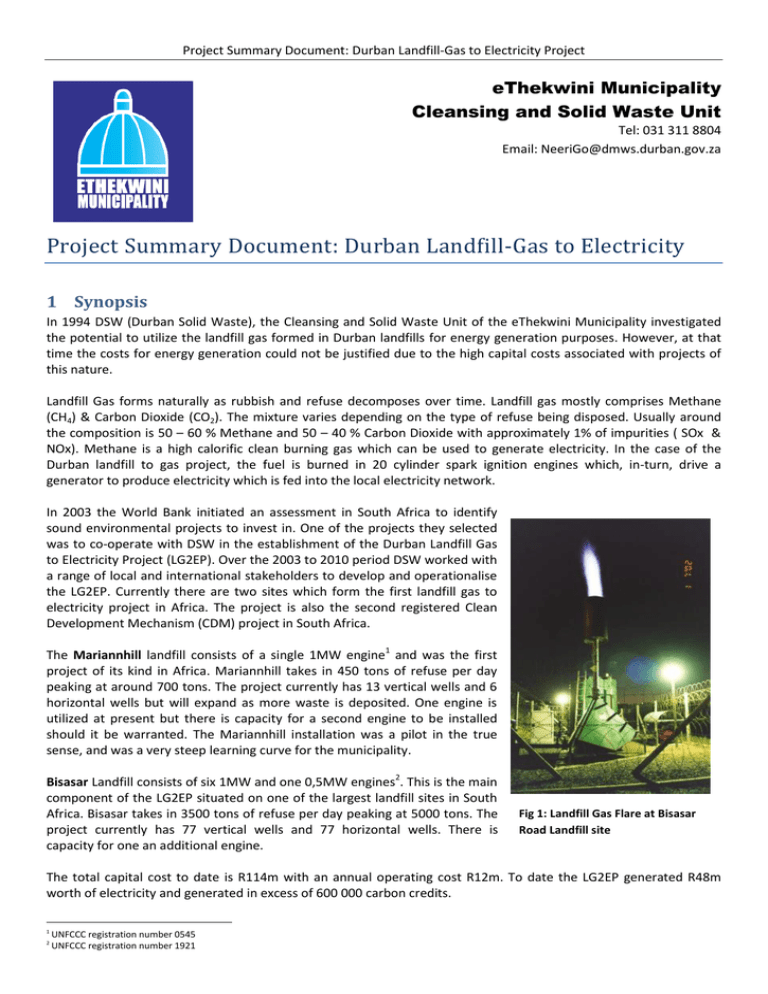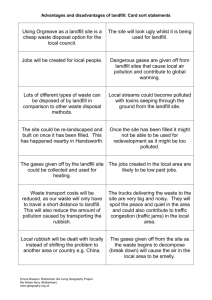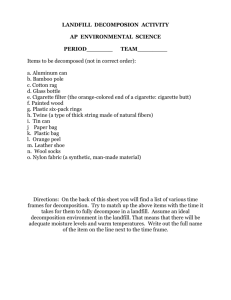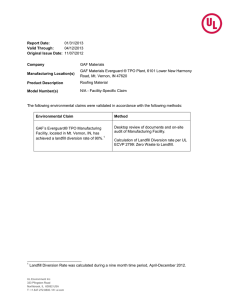eThekwini Municipality Cleansing and Solid Waste Unit
advertisement

Project Summary Document: Durban Landfill-Gas to Electricity Project eThekwini Municipality Cleansing and Solid Waste Unit Tel: 031 311 8804 Email: NeeriGo@dmws.durban.gov.za Project Summary Document: Durban Landfill-Gas to Electricity 1 Synopsis In 1994 DSW (Durban Solid Waste), the Cleansing and Solid Waste Unit of the eThekwini Municipality investigated the potential to utilize the landfill gas formed in Durban landfills for energy generation purposes. However, at that time the costs for energy generation could not be justified due to the high capital costs associated with projects of this nature. Landfill Gas forms naturally as rubbish and refuse decomposes over time. Landfill gas mostly comprises Methane (CH4) & Carbon Dioxide (CO2). The mixture varies depending on the type of refuse being disposed. Usually around the composition is 50 – 60 % Methane and 50 – 40 % Carbon Dioxide with approximately 1% of impurities ( SOx & NOx). Methane is a high calorific clean burning gas which can be used to generate electricity. In the case of the Durban landfill to gas project, the fuel is burned in 20 cylinder spark ignition engines which, in-turn, drive a generator to produce electricity which is fed into the local electricity network. In 2003 the World Bank initiated an assessment in South Africa to identify sound environmental projects to invest in. One of the projects they selected was to co-operate with DSW in the establishment of the Durban Landfill Gas to Electricity Project (LG2EP). Over the 2003 to 2010 period DSW worked with a range of local and international stakeholders to develop and operationalise the LG2EP. Currently there are two sites which form the first landfill gas to electricity project in Africa. The project is also the second registered Clean Development Mechanism (CDM) project in South Africa. The Mariannhill landfill consists of a single 1MW engine1 and was the first project of its kind in Africa. Mariannhill takes in 450 tons of refuse per day peaking at around 700 tons. The project currently has 13 vertical wells and 6 horizontal wells but will expand as more waste is deposited. One engine is utilized at present but there is capacity for a second engine to be installed should it be warranted. The Mariannhill installation was a pilot in the true sense, and was a very steep learning curve for the municipality. Bisasar Landfill consists of six 1MW and one 0,5MW engines2. This is the main component of the LG2EP situated on one of the largest landfill sites in South Africa. Bisasar takes in 3500 tons of refuse per day peaking at 5000 tons. The project currently has 77 vertical wells and 77 horizontal wells. There is capacity for one an additional engine. Fig 1: Landfill Gas Flare at Bisasar Road Landfill site The total capital cost to date is R114m with an annual operating cost R12m. To date the LG2EP generated R48m worth of electricity and generated in excess of 600 000 carbon credits. 1 2 UNFCCC registration number 0545 UNFCCC registration number 1921 Project Summary Document: Durban Landfill-Gas to Electricity Project 2 Aims of the Project The Landfill Gas to Electricity Project (LG@EP) incorporates two landfills in the eThekwini Municipal Area (EMA) and will harness landfill gas to generate electricity. The landfill gas will be fed to spark-ignition electrical generating units for a current power production of 7.5MW. It is anticipated that up to 7.7 million tons of certified emission reductions (CER) could be realized by the project. 3 Background 3.1 eThekwini Waste Profile The eThekwini Metropolitan Area (EMA) produces over 1.8 million tonnes of waste a year, the majority of which is disposed of in landfill sites. Affluent communities produce up to 13 times more waste per person than poor communities and commercial and industrial activities are the main sources of hazardous waste. About 1.4 million tonnes of waste is land-filled in the EMA annually. This does not, however, reflect the total waste production in Durban which is in excess of 1.8 million tonnes a year. Considerable quantities of liquid waste are disposed of through marine pipelines. In addition, in many informal settlements, only an estimated 25% of waste reaches the formal waste stream. Of the waste which is land-filled, about 90% is general solid waste, with liquid and hazardous waste making up the balance. Most of the general and hazardous wastes generated in the EMA are land-filled in the city's general (G) and low hazard (H:h) landfill sites. There is no high hazard (H:H) site in the EMA or even the province of KwaZulu-Natal. A very small quantity of high hazard waste (approx 200 tonnes per annum) is currently exported out of KwaZulu-Natal to high hazard (H:H) landfill sites in Gauteng and the Eastern Cape. Some industrial effluent is treated and disposed of to the sewer. All treated sewage and industrial effluent from the central and southern sewage works is disposed of to sea via marine pipelines. In addition, there are two permitted industrial pipelines in the EMA which are used for disposal of certain industrial wastes. eThekwini Municipality’s Durban Solid Waste (DSW), operates a number of landfill sites including the two in the LG2EP, Bisasar Road and Mariannhill. Initially a third closed landfill site at La Mercy was considered as part of the LG2EP, but the low volume of methane emission was determined to be unviable. eThekwini Municipality recognized the need to control landfill gas emissions at Bisasar Road and Mariannhill respectively as these sites are in and near to urban areas and already have some active landfill gas extraction and flaring. 3.2 Bisasar Road Landfill Site The Bisaser Road Landfill is DSW's flagship landfill site. It is situated in the Springfield district in the Central Region, favorably placed with respect to the CBD and close to the Outer Ring Road, a major artery connecting the city to the west, north and south. It is conveniently located in close proximity to the DSW head office. The site is surrounded by both formal and informal residential housing, industries and open space. The site is positioned in an unstable valley line which was deemed unsuitable for residential use. The site was opened for operation in May 1980. It was issued with a permit by the Department of Water Affairs and Forestry in 1996 and is classified as a General Large Site (G:L:B+). Access to the site is via Dhulam Road, access is controlled and the entire site is fenced. Three 60-ton weighbridges have been installed. All waste coming onto site is recorded by means of software developed in-house. The site is operated by DSW staff falling under the Plant and Disposal Branch. A Monitoring Committee consisting of Local, Provincial and State Government officials, I & APs and members of the public meet on a regular basis. The objective of this committee is to ensure that the standards set out in the Permit are adhered to and that the site is run to acceptable norms and standards. The remaining air space as at June 2002 was estimated at 10.5 million cubic meters. Estimated remaining life span, taking into account normal growth, is 15 years. Project Summary Document: Durban Landfill-Gas to Electricity Project 3.3 Mariannhill Landfill Site The Mariannhill landfill site is situated in Mariannhill in the Inner West Region. Residential areas, forestry and open space surround the site which has been in operation since July 1997. Access is controlled and the entire site is enclosed with security fencing and lockable gates. Incoming waste is regulated and recorded by a system of weighbridges. The site is operated by DSW staff falling under the Plant and Disposal Branch. A Monitoring Committee consisting of Local, Provincial and State Government officials, I & APs and members of the public meets on a regular basis. 4 Technology Utilized For Project DSW commissioned the installation of landfill gas extraction wells, flare units and landfill gas generators for the identified landfill sites. DSW functions as the technical advisor and operator of the project. Specifically, the following technologies are installed: Extraction wells: Some 77 vertically driven gas wells and 77 horizontal wells at Bisasar Road and 13 vertical wells and 6 horizontal wells at Mariannhill were constructed to extract the landfill gas as it is produced Gas collection pipework: These pipes collect and transport the gas from the wells to the extraction plant from where the gas will be used for electricity generation, with any surplus gas being flared Gas extraction plant (blower): A centrifugal blower is required to extract landfill gas from the wells and supply this to either the generation engines or the flare unit. The blower creates lower pressure inside the wells than in the landfill, thereby sucking the gas from the landfill into the wells and from there to the extraction plant Flare units: A landfill gas flare with minimum capacity of 1,000Nm3/hr was installed at each site Landfill gas generators: A single 1MW unit was installed (at Marianhill) and six 1MW and one 0,5MW engines at Bisasar (Jenbacher type 320 engines). Switch gears, transformers and cabling: as needed for the interconnection with the eThekwini Electricity grid Fig 2: Jenbacher Engines installed at Bisasar Road Landfill Site This project composes of two complementary components as follows: 1. Collection, flaring, and combustion of landfill gas, thus converting its methane content into CO2 and reducing its greenhouse gas effect; and 2. Generation and supply of electricity to the regional grid, thus displacing electricity generation from thermal (mainly coal) power plants. Project Summary Document: Durban Landfill-Gas to Electricity Project 5 Emission Reduction Credits During the World Summit on Sustainable Development hosted by South Africa (WSSD, Johannesburg, 2002), officials from the Prototype Carbon Fund (PCF), a fund organization managed by the World Bank, approached Durban Solid Waste (DSW) to propose the development of a landfill gas utilization project. Because of DSW’s advanced research collaboration with the University of KwaZulu-Natal into the management of landfill gas emissions, eThekwini Municipality were the first South African municipal authority to be approached by the World Bank. The primary purpose of the project is electricity generation and it is characterized as a municipal auto generation project. However, the project does not present an economically attractive investment opportunity as energy generation as the proposed project is more costly than the continued purchase of electricity from the national utility company. Eskom, one of the project sponsors would not invest in the project in the absence of additional finance. The project has therefore been packaged as a Clean Development Mechanism and will generate certified emission reductions that would not occur otherwise. The Kyoto Protocol also attaches a value to the GHGs based on how harmful it is to the environment, this is known as its global warming potential (GWP). Using this standard, one unit of CH4 is identified as being 23 times more harmful than one unit of CO2. Landfill gas typically contains 60 percent CH4 and 40% CO2 as it is generated. CH4 has at least 23 times more effect on global warming than CO2. Therefore, CH4 has got to be a key gas to address in reducing global warming. European Union countries, and the majority of first world countries, have legislation to control the landfill emissions and combust landfill gas. When landfill gas is combusted the CH4 is converted to CO2. However, some countries do not have legislation requiring the combustion of landfill gas, and landfill gas vents to atmosphere, with a greater impact on global warming. These countries qualify for the purchase of emission reductions (ERs). Emission Reductions (ER) credits will therefore make the LG2EP viable, and successful development of this project should provide an internal rate of return in excess of 25 percent for the municipality. The project agreement will be for the sale of 3.8 million tons emission reductions over the maximum period of 21 years. A percentage of the sale of credits will be allocated to a social benefit program. In this regard the PCF has agreed that the total amount that the project will generate for the social benefit project may be payable 'up front'. The City is to identify suitable community projects for this social benefit payment, which are to meet with the City’s sustainable development criteria. Additionally, the project will facilitate the allocation of capital funds to enable the extraction of the landfill gasses which have caused distinct odor concerns to surrounding communities. The CDM documentation for Project 1921: Durban Landfill-Gas Bisasar Road Bisasar can be found here http://cdm.unfccc.int/Projects/DB/TUEV-SUED1214927681.45 The CDM documentation for Project 0545 : Durban Landfill-gas-to-electricity project – Mariannhill and La Mercy Landfills can be found here http://cdm.unfccc.int/Projects/DB/TUEV-SUED1154520464.04






